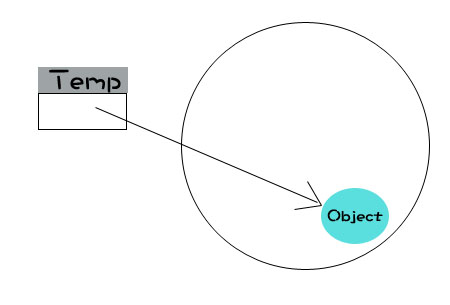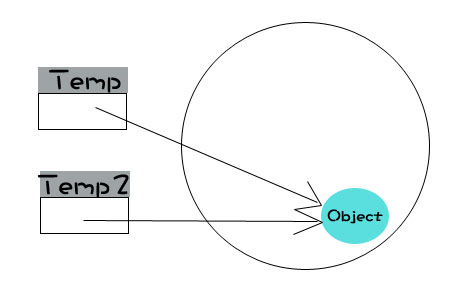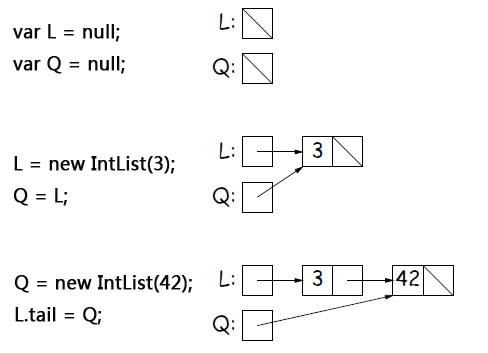Javascript引用指针使用介绍
请尝试完成下列完形填空:
/* 创建一个队列,头为head0,尾为tail0 */
function IntList(head0, tail0){
this.head = head0 || 0;
this.tail = tail0 || null;
}
/* 返回一个IntList包含数组中的所有数 */
IntList.list = function(__args){
var sentinel = new IntList(),
len = __args.length,
p = sentinel;
for(var i = 0; i < len; i++){
p.tail = new IntList(__args[i]);
p = p.tail;
}
return sentinel.tail;
};
/* 返回该对象的字符串表示 */
IntList.prototype.toString = function(){
var temp = "";
temp += "[";
for(var L = this; L !== null; L = L.tail){
temp = temp + " " + L.head;
}
temp += " ]";
return temp;
};
/** 返回一个IntList,包含IntList A和IntList B,
* 其中B的元素在A的后面。不能使用new关键字。
*/
function dcatenate(A, B){
/* 完成功能 */
}
/** 返回一个新的IntList,其长度为len,
* 以#start元素为开头(其中#0是第一个元素),
* 不能改变L。
*/
function sublist(L, start, len){
/* 完成功能 */
}
这是一个用Javascript写的链表题。由于链表拥有较为复杂的引用操作,正好可以用来考察下对Javascript的引用的理解。附带简单的测试用例:
/* 测试dcatenate和sublist函数是否正确 */
function test(){
var A = IntList.list([4,6,7,3,8]),
B = IntList.list([3,2,5,9]);
dcatenate(A, B);
if(A.toString() === "[ 4 6 7 3 8 3 2 5 9 ]"){
alert("dcatenate函数正确。");
}else{
alert("dcatenate函数错误。");
}
var L = IntList.list([3,4,5,2,6,8,1,9]),
result = sublist(L, 3, 3);
if(result.toString() === "[ 2 6 8 ]"){
alert("sublist函数正确。");
}else{
alert("sublist函数正确。");
}
}
Javascript引用?
实际上,在对变量赋予引用类型实例时,变量保存的是该实例的引用:
var temp = new Object();

这种表现非常切合它的名字,引用类型,其实例当然是来引用的。
而当将该变量再付给另一个变量的时候,实际上只是进行了对引用的复制操作:
var temp2 = temp;

所以虽然从定义式来看:temp2 = temp,但他们并没有直接联系,例如修改了temp的引用:
var temp = {
name: "temp"
};
var temp2 = temp;
temp = {
name: "not temp2"
};
temp === temp2; //false
当然,如果我们修改的只是指针指向的实例本身,那么temp2依然等于temp:
var temp = {
name: "temp"
};
var temp2 = temp;
temp.name = "also temp2";
temp === temp2; //true
IntList是什么东东?
我们来分析一下下图:

- 创建两个空的变量,所以右图中L和Q是空的。创建一个新的IntList其头部为3,尾部为空,将L引用的值赋给Q,所以L和Q都指向这个新的IntList。Q指向一个新创建的IntList其头部为42,尾部为空,将Q的指针赋给L.tail,这样两个IntList被套嵌起来。
可见IntList是个通过指针达到多重套嵌的数据结构,被称为链表(Linked List)。
1.创建两个空的变量,所以右图中L和Q是空的。2.创建一个新的IntList其头部为3,尾部为空,将L引用的值赋给Q,所以L和Q都指向这个新的IntList。
3.Q指向一个新创建的IntList其头部为42,尾部为空,将Q的指针赋给L.tail,这样两个IntList被套嵌起来。
可见IntList是个通过指针达到多重套嵌的数据结构,被称为链表(Linked List)。
IntList合并
我们只需要将其中一个的尾部指向另一个就行了。这样这两个IntList就连接起来了:
/** 返回一个IntList,包含IntList A和IntList B,
* 其中B的元素在A的后面。不能使用new关键字。
*/
function dcatenate(A, B){
var p;
for(p = A; p != null; p = p.tail){
if(p.tail === null){
p.tail = B;
break;
}
}
return A
}
IntList截取
由于题目要求不能改变原IntList,所以我们只能从原IntList取出数据再重建一个新的数据。
/** 返回一个新的IntList,其长度为len,
* 以#start元素为开头(其中#0是第一个元素),
* 不能改变L。
*/
function sublist(L, start, len){
var K,
P,
J;
var i = 0,
end = start + len;
for(P = L; i <= end; P = P.tail, i++){
if(i < start){
continue;
}else if(i === start){
K = new IntList(P.head);
J = K;
}else if(i > start && i < end){
J.tail = new IntList(P.head);
J = J.tail;
}else if(i >= end){
break;
}
}
return K;
}
思考题
1.函数传参数的时候是怎么传的?例如下面代码的引用过程是怎样的?
var obj = {
name: "anything"
};
function getName(__obj){
return __obj.name;
}
var name = getName(obj);